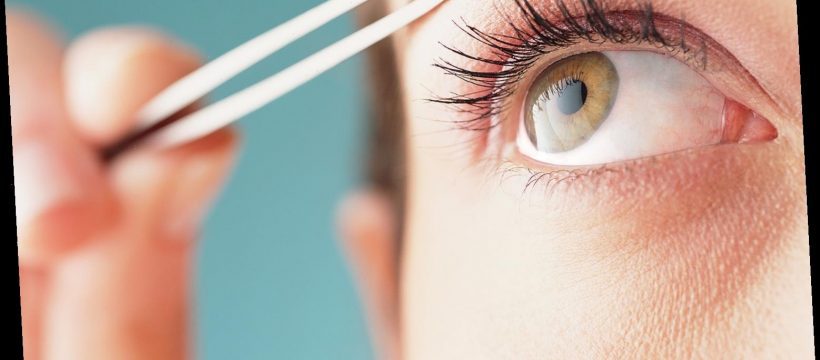Now that social distancing and self-isolation are becoming the new norm amid the escalating coronavirus (COVID-19) crisis, people are Googling at-home solutions to beauty treatments they used to outsource. But while there are plenty of ways to practice self-care without going to the salon or spa, there are some things that should be left to the pros.
Read on to find out exactly why you shouldn’t be taking these five beauty treatments into your own hands — as tempting as it may be.
Don’t Touch Your Eyebrows
If you’re still traumatized by the days of the ultra-thin over-plucked ’90s brows (like plenty of celebs we’ve talked to), don’t pick up the tweezers while you’re hanging out at home. It’s so easy to go from tweezing off a few stray hairs to stepping back and realizing you have no bushy arches left, so take this time to let your brows grow.
RELATED: How to Safely Remove Your Gel or Acrylic Manicure at Home
But if you feel like your arches are becoming really unruly, simply brush through a clear brow gel (or some hairspray spritzed on an old toothbrush if you’re in a pinch) to keep them polished during the day.
Dr. Michael Brinkenhoff, founder & CEO RevitaLash Cosmetics, says that makeup, aging and environmental stressors can make brows appear “dull, brittle and lackluster,” so he developed the RevitaBrow Advanced Eyebrow Conditioner to help them look better than ever. “The ingredients like peptides and green tea extract work together to improve brow health leading to more beautiful looking, more defined, and fuller looking brows,” he says.
If You’re a Waxer, Try to Avoid Shaving
Longtime waxers: now isn’t the time to start shaving once your hair starts growing in. Repeating waxing slows down the hair growth and allows it to grow in much thinner, but once you pick up a razor, it negates all your progress (light hair with a fresh razor will be okay). “Coarse hair on the bikini line should not be shaved. This will create ingrown hairs,” says Cindy Barshop, founder women’s intimate health spa, VSPOT.
While Barshop doesn’t recommend attempting to wax your bikini line at home if you’ve never done it before, she does suggest a foam hair remover like Nair in the meantime.
“Read the instructions carefully and test on a small area. Even if it’s not completely hair-free this will minimize the amount of pain the next time you wax,” Barshop says. “You can trim it very carefully too — just not too close!”
Don’t Cut Your Own Hair
With plenty of time on your hands, you may feel inspired to make a dramatic hair change — but trust us, now is not the time do it. “don’t know who needs to hear this, but this is not the time to cut your bangs at home ✂️🙅🏻♀️,” celebrity hairstylist Justine Marjan said on Instagram.
The same goes for a regular haircut too. Unless a trained hairstylist yourself, the chances the chop will come out as you imagine are pretty slim. Keep your mane healthy with a weekly hydrating hair treatment (we love this nourishing coconut oil mask from Coco & Eve) and schedule a trim after your self-isolation ends.
RELATED: Should You Cancel Hair and Nail Appointments amid Coronavirus? This Expert Says Yes
Don’t Go Lighter
Getting highlights or going blonde isn’t as easy as going darker, which is why a blond dye job is best left to professional colorists. “Otherwise, you may be stuck with a color correction nightmare a.k.a. spending a lot of money when going to your colorist for a 911 hair appointment,” says colorist at Cutler Salon, Adrianna Norton.
Nine Zero One colorist Nikki Lee and Garnier brand ambassador Nikki Lee adds, “It’s always easier to go slightly darker than lighter at home.”
Don’t Use Too Much Skincare
Now isn’t the time to dig up every sheet mask, serum and intense facial tool from the back of your beauty cabinet to test out on your skin. Introducing many new skincare products at once can lead to irritation and redness. “When you’re introducing new products, it’s really important to add them in slowly,” says Shani Darden, celebrity esthetician and founder of Shani Darden Skin Care. “You never want to add in too many new products at once because you won’t be able to pinpoint what actually works for your skin.”
When trying new skincare, she suggests doing it one at a time, “especially when they have active ingredients like lactic acid, retinol or salicylic acid.” Darden adds, “Wait a few days before you try another new product so you can give your skin time to acclimate and see what works.”
And as more people continue to self-isolate, you might not be able to book an appointment with a derm if you skin does have a really bad reaction. But for immediate relief, Darden says to switch to “soothing, calming products” instead.
“Make sure you’re using a gentle cleanser like Cleansing Serum which has oat bran extract to repair the skin’s barrier and help prevent moisture loss. This is essential when skin is irritated! To keep the skin hydrated, you can use a lightweight moisturizer like Weightless Oil-Free Moisturizer. Aloe is also an incredible treatment to soothe inflamed skin!” Darden explains.
As information about the coronavirus pandemic rapidly changes, PEOPLE is committed to providing the most recent data in our coverage. Some of the information in this story may have changed after publication. For the latest on COVID-19, readers are encouraged to use online resources from CDC, WHO, and local public health departments and visit our coronavirus hub.
Source: Read Full Article

